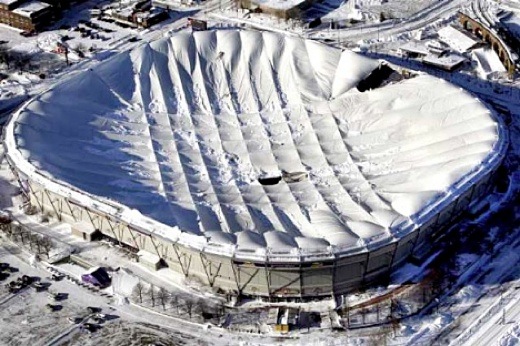 Image above: The collapsed roof of the Twin City Metrodome. From original article.
Image above: The collapsed roof of the Twin City Metrodome. From original article.
People build air supported domes like the Hubert Humphrey Metrodome for two reasons: They are quick and they are cheap. The whole stadium was an exercise in cheapness, being described in Wikipedia by one official as a place to "get fans in, let 'em see a game, and let 'em go home."
I didn't think it was news when it collapsed the other day; it is the fourth time, and it happens to all of these bunion pad stadia. But this one has got a lot of attention, and has even been the subject of a musical remix by Vanilla Brice. Perhaps it deserves a closer look.
The 28 year old Metrodome roof is made from fiberglass fabric 1/16th of an inch thick coated with teflon for protection from ultraviolet light. There is an inner acoustic absorption layer hanging from it; warm air is circulated between the two layers to melt snow on the roof. The 580,000 pounds of roof are held up by the air pressure supplied by 20 90 horsepower fans. It is designed for snow loads.
But while air supported roofs are cheap and fast to build, they are expensive to operate and maintain, and they don't last very long. When Birdair Structures, (these were invented by Walter Bird in 1946) the builder of the dome, inspected it last spring they noted:
The membrane was weathering as anticipated and had exceeded its service life of 20 years; it recommended planning for replacement of the roof fabric, and noted that planning and implementation would take an additional five years and cost $12-$15 million.
According to the Buffalo News, (home of Birdair)
A snowstorm battered the Midwest over the weekend, dumping 17 inches of snow on the Twin Cities. Stadium officials tried in vain to keep snow from accumulating on the roof. An interior heating system tried to melt the pileup. Workers went on the roof with hoses to blast hot water but had to stop due to dangerous winds. Three holes could be seen in the roof after the collapse.
The possibility of this happening was clearly not a surprise, nor was the result catastrophic; the roof slowly deflated and came to rest on its cables. But it is a great demonstration that fast and cheap is no substitute for good or green.
Air supported roofs suck a lot of energy to keep up, to heat, and they don't last. They are hangovers from an era when people built charmless complexes (some roofed, some not) fast and cheap; As Chris Erskine wrote in the Los Angeles Times:
30 years seems about right for modern arenas. In the old days, they built places that could last a century. Fenway. Wrigley. Boston Garden. Madison Square Garden. They were built by two guys with a hammer and a bucket for cement. There's one in Rome that's pretty old too.I have quoted Steve Mouzon many times:Today, stadiums are built like double-wide trailers, virtually disposable. The Metrodome's crummy next-of-kin included the Seattle Kingdome, Veterans Stadium in Philly, the Pontiac Silverdome.

The Metrodome was not lovable; it was brutal and ugly and cheap. It was not durable; one sixteenth of an inch of fiberglass is not going to last. It was not particularly flexible, incapable of adapting to the seasons and it certainly wasn't frugal, needing continuous supply of electricity just to stay up.
They will stick on a few patches, reinflate it and be playing inside again soon. But it will remain an object lesson in how not to build. Video above: Mashup of Twin City Metrodome roof collapse. From (http://www.youtube.com/watch?v=oyEOWgGihU4). .
No comments :
Post a Comment